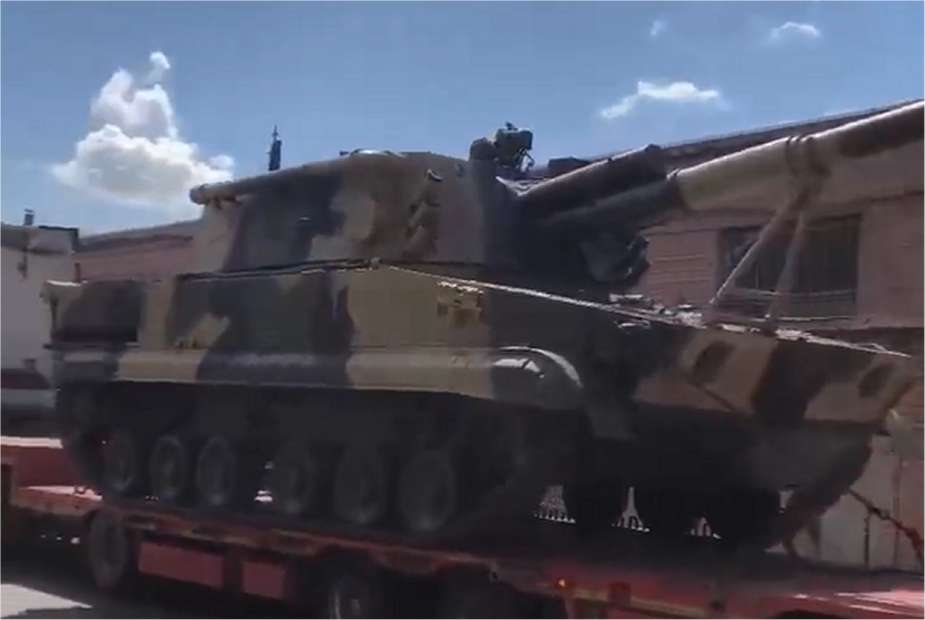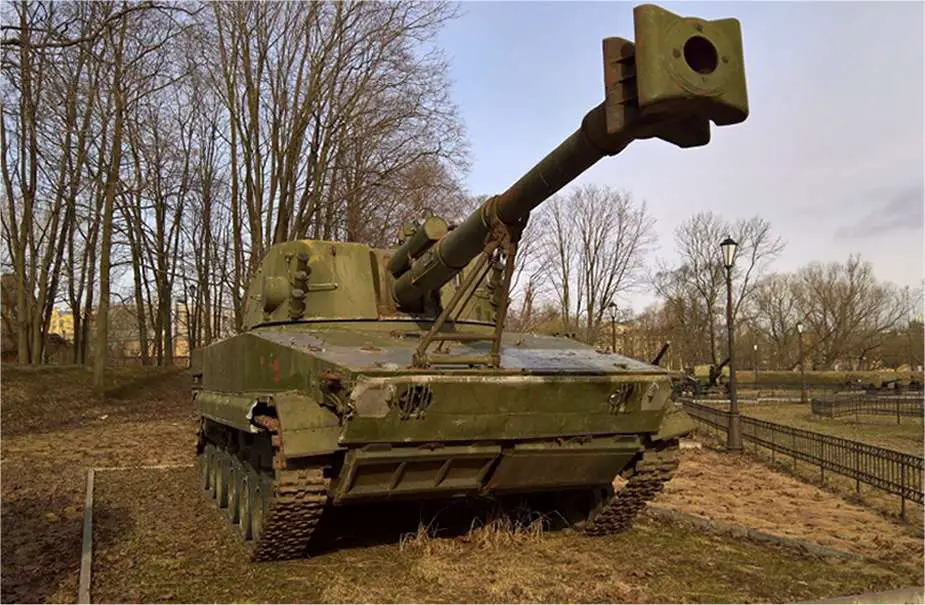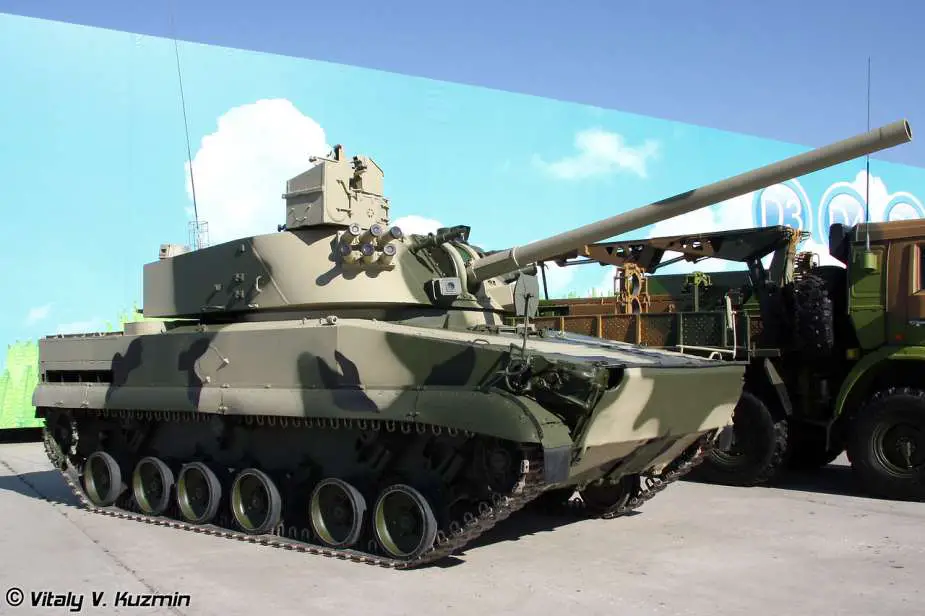Russia uses 2S18 prototype as blueprint to produce 152mm self-propelled howitzer
According to a video published on Telegram on August 8, 2023, the Russian Kurgan Machine-Building Plant is working on the production and modernization of the 2S18 Pat-S 152-mm self-propelled howitzers based on the BMP-3 Infantry Fighting Vehicle (IFV) chassis, using the single prototype as a blueprint for a new 152mm amphibious self-propelled howitzer.
Follow Army Recognition on Google News at this link

The 2S18 Pat-S 152mm self-propelled howitzer prototype at Russian Kurgan Machine-Building Plant (Picture source Telegram)
Back in April 2017, observers spotted the lone manufactured prototype of the 152-mm self-propelled howitzer, known as the 2S18 Pat-S, situated within the premises of the Military Historical Museum of Artillery in St. Petersburg.
In terms of established technical details, this prototype measures 6.85 meters in length and 3.36 meters in width, accompanied by a weight of 18.7 tons. Its design features a 152-mm rifled howitzer, specifically the 2A63, sharing ballistic traits with its towed counterpart, the 2A61 "Pat-B." This versatile armament can employ various types of ammunition compatible with 152-mm guns D-1, ML-20, and D-20.
Notably, its ballistic performance closely resembles that of the ML-20 gun, particularly evident when utilizing a reduced variable charge No. 3. A UTD-29 diesel engine with a V-shaped 10-cylinder configuration constitutes the power source, capable of delivering a maximum power output of 450 hp. The presence of a hydromechanical transmission system, offering 4 forward and 2 reverse gears, facilitates calculated speeds of 72 km/h when moving forward and 21 km/h when in reverse.
The historical context of this prototype is interesting. In the early 1980s, the Soviet Union initiated the 2S18 Pat-S project in response to evolving NATO standards in self-propelled artillery. The intention was to strike a balance between firepower and reduced size and weight, with the aim of achieving innovation while maintaining practicality. However, the project faced challenges that ultimately prevented its integration into the Soviet military arsenal, despite its ambitious goals.
The 2S18 Pat-S was developed as a successor to the notable "plant series" of Soviet self-propelled artillery platforms, including the 2S1 Gvozdika and 2S3 Akatsiya. The evolving NATO practice of adopting a unified 155-millimeter caliber for self-propelled artillery prompted the Soviets to explore similar adaptations. The Pat-S project emerged as an effort to deliver the firepower of the 2S3 Akatsiya within a compact framework. The Kurgan Machine-Building Plant spearheaded the initiative, grappling with engineering challenges such as finding a chassis capable of withstanding the recoil of a large-caliber gun or installing a gun with reduced recoil on a new self-propelled platform.
The newly developed tracked chassis of the BMP-3 infantry fighting vehicle served as the foundation for the 2S18 self-propelled howitzers. This chassis was equipped with a multi-fuel 10-cylinder UTD-29 diesel engine with a capacity of 450 horsepower. With this power source, the Pat-S self-propelled howitzer could reach speeds of 70 kilometers per hour on highways and cover up to 600 kilometers with a single refueling. Additionally, the use of the BMP-3 chassis allowed the new combat vehicle to navigate water bodies at speeds of up to 10 km/h.
A spacious rotating turret was installed on the modified armored hull shoulder strap. The primary weapon of the 2S18 was the 152mm 2A61 Pat-B howitzer, originally designed as a towed howitzer for regimental artillery but adapted for self-propelled use.
Weighing 4.3 tons, the 152-mm rifled howitzer 2A61 measures 6360 mm in length, 2200 mm in height, and 1970 mm in width when stowed, with a track width of 1840 mm. Its ammunition includes OFS shells weighing 43.56 kg. The gun achieves a firing rate of 6-8 shots per minute, propelling projectiles at an initial velocity of 540 m/s. It boasts an elevation range from -5 to +70 degrees and offers a full 360-degree horizontal guidance angle. Effective firing spans from 4000 to 15014 meters. Additionally, it can be towed at speeds of up to 80 km/h on highways.
Before incorporation into a self-propelled chassis, the 2A61 Pat-B underwent modifications, resulting in the designation 2A63. A key consideration for selecting this gun was its relatively low recoil. The original 2A61 howitzer was built upon a modified carriage from the 2A18 (D-30) 122mm gun, featuring a smaller caliber and consequently lower recoil energy. To prevent structural damage, the new howitzer was equipped with effective recoil mechanisms and an original muzzle brake.
Similar to other domestic 152 mm caliber artillery, the 2A63 howitzer employed separate-sleeve loading. To streamline crew operations, the gun featured a ramming mechanism. Interestingly, this mechanism was initially designed for the towed howitzer version and underwent adaptations for self-propelled usage, enabling skilled gunners to achieve firing rates of up to eight rounds per minute.

In 2017, the 2S18 Pat-S was seen at the Military Historical Museum of Artillery in St. Petersburg (Picture source Yandex)
For self-defense, the 2S18 Pat-S was equipped with a PKM machine gun on a turret near one of the tower hatches, along with smoke grenade launchers. Additionally, the crew had access to personal armaments like machine guns and grenades for self-protection after deployment.
The outcome was a relatively compact and lightweight self-propelled artillery platform, transportable by existing military aircraft and potentially deployable by parachute. Despite its reduced weight, the new 2S18 self-propelled howitzer delivered formidable firepower and could accommodate all available 152 mm caliber shells, including potential nuclear variants. Moreover, the Pat-S combat vehicle boasted amphibious capabilities, negating the need for bridges and facilitating independent water crossings.
However, during early 1980s trials, the 2S18 Pat-S failed to meet military expectations. Concrete reasons for the Ministry of Defense's dismissal of the promising self-propelled howitzer remain elusive, but speculations abound. Notably, while the armored hull, powerplant, and undercarriage of the Pat-S drew no notable criticisms and were subsequently retained for the new 2S31 Vena self-propelled howitzers, shortcomings likely pertained to the armament system.
Despite its larger caliber and more potent charge, the 2S18 Pat-S 152-mm self-propelled howitzer's shell range was limited to 15 kilometers, identical to the 122-mm self-propelled howitzer 2S1 Gvozdika. Consequently, the new 152 mm caliber gun outperformed the old 122 mm gun only in projectile potency and partly in firing rate. Compared to the existing 2S3 Akatsiya self-propelled artillery of 152 mm caliber, the Pat-S exhibited no exceptional advantages. The older 2S3 self-propelled howitzer possessed a range of up to 20 kilometers and accommodated up to 46 rounds in its combat compartment. Though exact figures vary, Pat-S ammunition loads reportedly ranged from 35 to 40 shells and corresponding charges.
Ultimately, the 2S18 project's pros and cons resulted in a delicate equilibrium. While the lightweight construction facilitated transportability and aquatic capabilities, the armament either lacked advantages over existing systems or lagged behind them in certain aspects. This intricate balance led to the project's discontinuation.

The 2S18 Pat-S served as a base for the 2S31 Vena 120mm self-propelled mortar (Picture source Vitaly Kuzmin)
The subsequent journey of the components from the failed self-propelled howitzer project unveils an intriguing tale. The 2A61 towed howitzer "Pat-B" sporadically emerges at various exhibitions and is marketed for export (M-389 variant for 155 mm NATO munitions). The early 1990s witnessed the Pat-K project, aiming to mount the 2A61 howitzer onto the Ural-5323 wheeled chassis. However, this endeavor also failed to proceed to production. The BMP-3 chassis emerged as a more promising option, subsequently modified for the 2S18 self-propelled howitzer. During the latter half of the 1980s, design work commenced on the new self-propelled howitzer, the 2S31 Vena, a 120mm self-propelled mortar, initially slated for construction on a modified Gvozdika chassis but later shifting to the Pat-S chassis.
Currently, several 2S31 Vena self-propelled mortars serve within Russia's missile forces and artillery. The sole constructed prototype of the 2S18 "Pat-S" self-propelled howitzer played a role in the development of the Vena prototype during the 1990s. Reports suggest that its chassis remained stored in Perm, within the Motovilikha Plants enterprise's premises. Until now, the fate of the 2S18 Pat-S had remained an enigma.


























